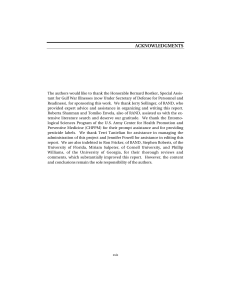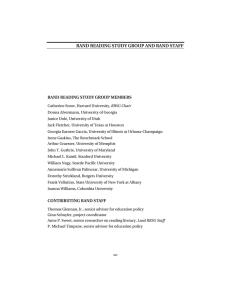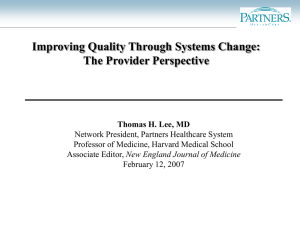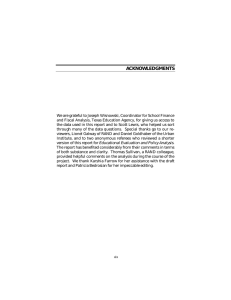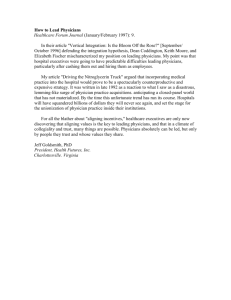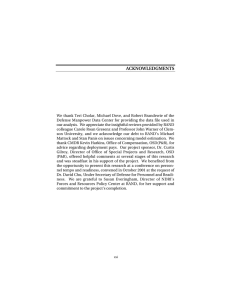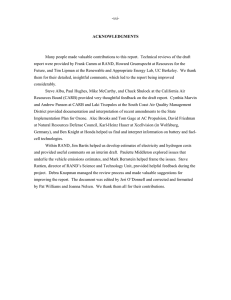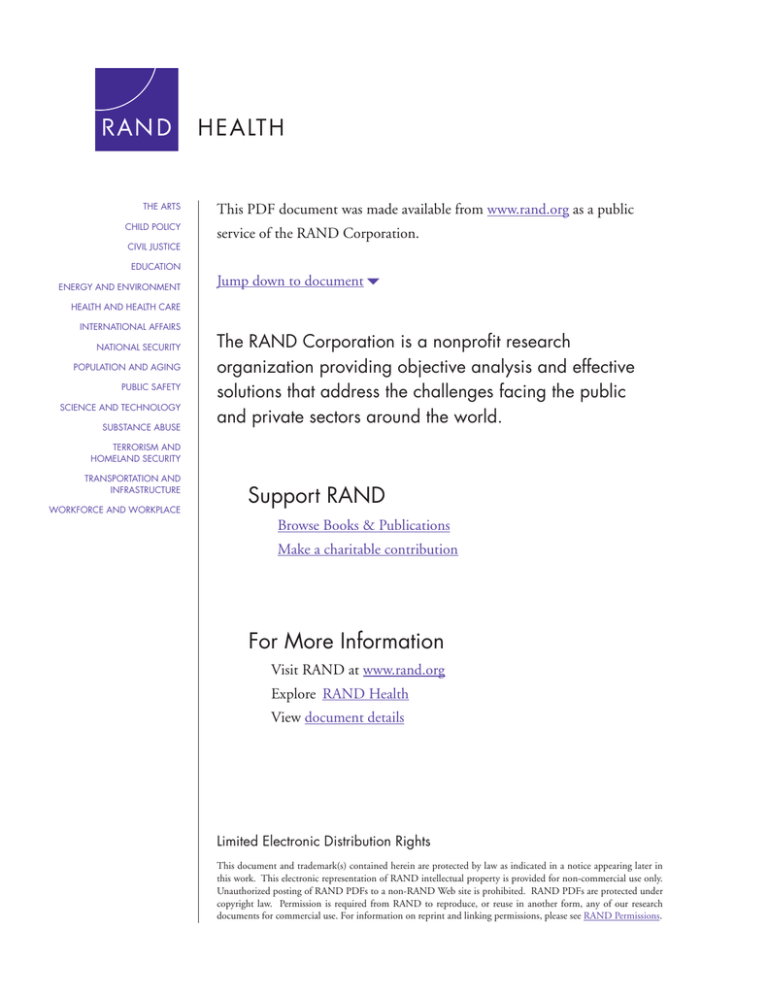
THE ARTS
CHILD POLICY
CIVIL JUSTICE
EDUCATION
ENERGY AND ENVIRONMENT
This PDF document was made available from www.rand.org as a public
service of the RAND Corporation.
Jump down to document6
HEALTH AND HEALTH CARE
INTERNATIONAL AFFAIRS
NATIONAL SECURITY
POPULATION AND AGING
PUBLIC SAFETY
SCIENCE AND TECHNOLOGY
SUBSTANCE ABUSE
The RAND Corporation is a nonprofit research
organization providing objective analysis and effective
solutions that address the challenges facing the public
and private sectors around the world.
TERRORISM AND
HOMELAND SECURITY
TRANSPORTATION AND
INFRASTRUCTURE
WORKFORCE AND WORKPLACE
Support RAND
Browse Books & Publications
Make a charitable contribution
For More Information
Visit RAND at www.rand.org
Explore RAND Health
View document details
Limited Electronic Distribution Rights
This document and trademark(s) contained herein are protected by law as indicated in a notice appearing later in
this work. This electronic representation of RAND intellectual property is provided for non-commercial use only.
Unauthorized posting of RAND PDFs to a non-RAND Web site is prohibited. RAND PDFs are protected under
copyright law. Permission is required from RAND to reproduce, or reuse in another form, any of our research
documents for commercial use. For information on reprint and linking permissions, please see RAND Permissions.
This product is part of the RAND Corporation technical report series. Reports may
include research findings on a specific topic that is limited in scope; present discussions of the methodology employed in research; provide literature reviews, survey
instruments, modeling exercises, guidelines for practitioners and research professionals, and supporting documentation; or deliver preliminary findings. All RAND
reports undergo rigorous peer review to ensure that they meet high standards for research quality and objectivity.
Forecasting the Supply of
and Demand for Physicians
in the Inland Southern
California Area
Megan K. Beckett, Peter A. Morrison
Prepared for the County of Riverside Economic Development Agency
HEALTH
The research described in this report was prepared for the County of Riverside Economic
Development Agency, and conducted within RAND Health, a division of the RAND
Corporation.
The RAND Corporation is a nonprofit research organization providing objective analysis
and effective solutions that address the challenges facing the public and private sectors
around the world. RAND’s publications do not necessarily reflect the opinions of its
research clients and sponsors.
R® is a registered trademark.
© Copyright 2007 RAND Corporation
All rights reserved. No part of this book may be reproduced in any form by any electronic or
mechanical means (including photocopying, recording, or information storage and retrieval)
without permission in writing from RAND.
Published 2007 by the RAND Corporation
1776 Main Street, P.O. Box 2138, Santa Monica, CA 90407-2138
1200 South Hayes Street, Arlington, VA 22202-5050
4570 Fifth Avenue, Suite 600, Pittsburgh, PA 15213-2665
RAND URL: http://www.rand.org
To order RAND documents or to obtain additional information, contact
Distribution Services: Telephone: (310) 451-7002;
Fax: (310) 451-6915; Email: order@rand.org
-xi-
SUMMARY
INTRODUCTION
In 2005, the University of California Health Sciences Committee
(UCHSC), the body responsible for advising on California’s state-run
secondary medical and allied health schools, predicted the likelihood of
a physician shortfall in California by the year 2020, based in large
part on a report issued by the University of Albany Center for Health
Workforce Studies (CHWS), commissioned by the state of California. This
report made a number of recommendations with respect to UC medical
education enrollment, including calling for an assessment of the
feasibility of developing one or more comprehensive new medical student
education programs by (or before) 2020.
In 2006, University of California, Riverside (located in Riverside
County), submitted a preliminary proposal to establish a school of
medicine. Almost simultaneously, University of California, Merced
(located in the San Joaquin Valley, in the central part of the state)
also submitted a preliminary proposal to establish a medical school.
A coalition of medical, civic, and other leaders who championed the
UC Riverside proposal asked RAND to independently assess the projected
demand and supply for physicians in the area surrounding UC Riverside in
the coming decades. This region is sometimes referred to as Inland
Southern California, the southeastern—most part of the state, and
comprises four counties: Riverside, San Bernardino, Inyo, and Imperial.
In addition, we examined projected supply and demand for the region
around UC Merced (the SJV region) and California overall.
COMPARING ISC, SJV, AND CALIFORNIA AS A WHOLE
California, the nation’s most populous state and one of its most
diverse, has eight medical schools, including five UC medical schools
and three private medical schools.
Combined, the ISC and SJV regions
contain 28 percent of the state’s population; yet, between them, they
contain only one medical school (Loma Linda University, a private school
in San Bernardino County).
-xii-
The per-capita income in ISC and SJV is lower than in the state as
a whole, with SJV considered one of the most economically distressed
regions in the United States.
According to most health indicators we
examined, the health of ISC and SJV residents is worse than the average
of those in the state.
FORECASTING THE PHYSICIAN SUPPLY IN ISC, SJV, AND CALIFORNIA
We used data from the American Medical Association Masterfile to
estimate the current supply of patient-care physicians (which includes
medical residents and fellows, hereafter referred to as residents) and
to project the supply in 2020 in the ISC, SJV, and the state. In 2004,
the ISC and SJV regions both had substantially fewer patient-care
physicians per 100,000 persons (128.7 and 138.4, respectively) than the
state as whole (222.6).
We then projected demand under four different hypothetical
scenarios.
Scenario 1 assumed the status quo in the training of
physicians in California that is, that recent annual rates of change in
the number of practicing physicians will persist through 2020.
Based on
this scenario, we projected that by 2020, SJV will have a slightly
higher number of physicians per capita (134.8) than ISC (127.3), and
both will remain well below the state average. Scenario 2 assumed a
gradual 20 percent increase in the number of residents above current
levels by 2020. Increasing the number of residents raises the supply of
patient-care physicians immediately (because most residents provide
patient care), and following completion of training, some residents will
choose to practice in the region and thus contribute to the “permanent”
supply of physicians. Scenario 2 produced a forecast of physicians per
capita that is 2.4 percent higher than Scenario 1 for the state, 2.1
percent higher for ISC, and only 0.9 percent higher for SJV (reflecting
the much smaller proportion of residents currently in SJV). Scenario 3
posited that UCR would open a new medical school and affiliated graduate
medical education programs according to its implementation schedule for
resident recruitment.
Scenario 4 posited both an increase in the
percentage of residents trained and a new medical school, which would
result in the largest gains in patient-care physicians per capita.
Even
- xiii
in Scenario 4, the most aggressive of the four, the projected (2020)
ratio of physicians to population for ISC (144.6) and SJV (136.3) would
remain at about half the statewide average (267.7).
Our assumptions are
relatively robust to different inputs for the physician-supply
projection component.
FORECASTING FUTURE DEMAND FOR PHYSICIANS IN ISC, SJV, AND CALIFORNIA
We used trend analysis to project physician demand at the county
level for the state as a whole and for SJV and ISC, separately.
Consistent with other national studies, we find strong evidence that the
number of physicians per capita is tied to such county-level economic
measures as average annual unemployment rates and median per-capita
income. Our study also incorporated population composition measures,
including age.
The number of physicians per 100,000 persons is greater in counties
with proportionally fewer persons under age 15, which may reflect a
lesser demand for physicians by younger populations. We found no
association between physicians per capita and a county’s race and ethnic
composition. Accounting for population and regional economic factors,
neither ISC nor SJV has significantly fewer physicians per 100,000 than
the state average.
Projecting to 2020, differences in physician demand among ISC, SJV,
and the state are again due to differences in population composition and
regional economy.
BALANCING SUPPLY AND DEMAND
We project that with no increase in the physician supply pipeline,
patient-care demand will exceed supply by about 60 physicians per
100,000 persons in ISC by 2020. If the number of first-year residents
who begin training in California were to increase starting in 2008
(Scenario 2), the projected gap would narrow slightly.
If UC Riverside
were to build a medical school and affiliated graduate medical education
programs as proposed (Scenario 3), the percentage gap between supply and
demand would decline by 24 percent. A similar decline (29 percent) in
the projected gap between supply and demand would result under Scenario
-xiv-
4, which both increases residents by 20 percent by 2016 and builds a new
medical school with affiliated residency programs in UCR (see Figure
S.1).
Patient care physicians per 100,000
Figure S.1. Projected Supply under Each Scenario Relative to Projected
Demand, ISC, 2020
200
Projected demand
180
160
140
120
100
80
60
40
20
0
1
2
3
4
Scenario
Our projections also predict that if the population and age
composition change as predicted by the state’s Department of Finance,
and if the rate of economic growth of SJV slows relative to ISC and the
state (as projected by the state), the supply of patient-care physicians
in SJV will fall short of demand by a smaller amount than that for ISC.
We emphasize that our demand model does not address the appropriate
proportion of physicians per capita; rather, it predicts demand based on
the current association between population, regional economy, and
physician utilization.
Forecasting physician supply and demand is challenging,
particularly for a time horizon over ten years.
The inherent difficulty
is magnified when projecting for small geographic units, such as
counties or groups of counties, because physicians are readily able to
move across such boundaries in response to local economic conditions or
population loss or gain.
Economic theory says that physicians will
follow demand for their services. Thus, our projected supply shortfalls
-xv-
in ISC and SJV are likely overestimated. Our model accounts for such
changes by assuming that the higher rates of physician growth in ISC and
SJV that have been observed in recent years relative to the state
average will grow closer to the state average in the future. But we note
that our supply projections are sensitive to how much we assume ISC and
SJV rates will approach the state mean.
Our report highlights conditions under which physician supply is
likely to partially close the gap with physician demand.
By monitoring
population composition and economic conditions, analysts can modify
their expectations about physician demand periodically and see how
demand is tracking with supply.
CONCLUSIONS
Our analyses suggest that under all the scenarios we considered,
the demand for physicians in ISC will exceed the supply if the recent
trends underlying our supply model continue. The analyses indicate that
a case can be made for moving forward with the UCR medical school
proposal if the goal is to close the projected physician demand-supply
gap in the ISC region.
We foresee a projected shortfall in the number
of patient-care physicians per capita necessary to meet the demand for
physicians in the four-county ISC region.
Opening the proposed UCR
medical school would close this projected gap by 16 percent, primarily
by increasing the number of medical residents and fellows (most of who
provide patient care) recruited as part of the affiliated graduate
medical education program. A second contributing factor would be the
increase in the expected retention of residents both regionally and in
the state. Our projection hinges strongly on assumptions about future
economic factors, age composition, and population change. It also
depends on future trends in physician work efforts.
For example, if
physicians were to reduce their patient-care hours by 10 percent between
now and 2020, the projected gap between physician supply and demand
would double.
Additional factors need to be considered when deciding whether and
where to open a new public medical school. One important factor is
whether the primary objective is to address future rather than current
-xvi-
regional and state health care needs: A person who begins medical school
this year is four to five years from being able to practice medicine as
a medical resident. Another goal in opening a new medical school might
be to increase the access of California residents and underrepresented
minorities to a medical education: Of the 44 states with at least one
medical school, California ranks 39th in medical school slots per capita
and 43rd in public medical school slots per capita.
Another advantage
might include reaping the economic costs and benefits of opening a new
medical school.

